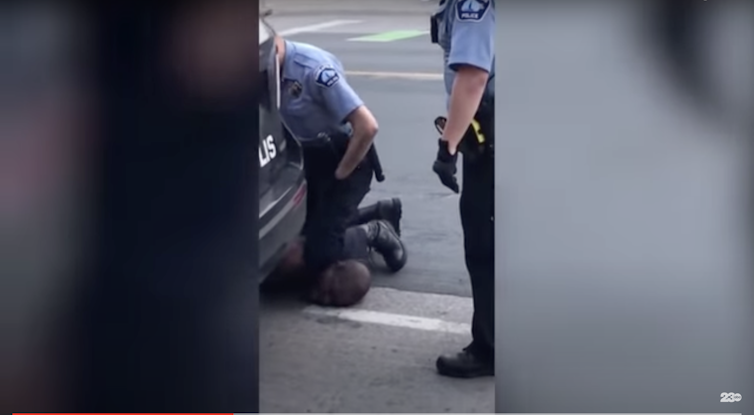Erik McGregor/LightRocket via Getty Images
by Rashad Shabazz, Arizona State University
The latest reminder that police officers around the country routinely deny Black people their constitutional rights comes from the Justice Department. This time, it’s about Minneapolis, the site of a police officer’s video-recorded murder of resident George Floyd.
More than three years after Floyd’s brutal death and the global protest movement that sprang from it, a June 2023 Justice Department report found that Minneapolis police use excessive force, including unjustified deadly force in their interactions with civilians, and discriminate against Black people.
The report echoes Justice Department findings, released in March 2023, about police misconduct in Louisville, Kentucky, where officers killed Breonna Taylor during an unlawful search of her home in March 2020, and about police in Ferguson, Missouri, in a report released in March 2015. An officer shot and killed Michael Brown, who was unarmed, during a 2014 encounter.
The Justice Department found that Minneapolis police also discriminate against Native Americans; routinely use excessive force, including “unreasonable use of tasers”; violate the rights of citizens exercising their First Amendment right to free speech; participate in racially discriminatory stops against Black people and Native Americans; and discriminate against people with serious mental illnesses.

23 ABC News – KERO
As a geographer and scholar of African American studies, I’ve written about racist policing for The Conversation before. So, I struggled to find a new way to examine the topic this time around. And that led me to the enduring question: Why is racial discrimination by police so common in the United States?
Policing in black and white
Justice Department reports, complaints from citizens and dozens of academic studies painfully point to racial discrimination by police as a common practice.
The evidence is overwhelming. Countless studies have shown that Black people are routinely stopped by police and live in racially segregated communities that police heavily monitor. These conditions have led to Black people being overrepresented in arrests for violent crime that doesn’t involve a fatality.
Police body camera footage shows officers speak disrespectfully to Black people during traffic stops; about four of every 10 Black people say police have unfairly stopped them; and Black people are more than three times as likely to be killed by police during interactions. These experiences explain why Black people have negative views of police.
For white Americans, however, their feelings and interactions with the police are more positive. For instance, only a quarter of white people surveyed report being in situations where they believe police were suspicious of them. Meanwhile, 78% feel police protect people from crime; 75% say police use the correct amount of force and that they treat people of color and white people equally; and 70% of white Americans feel police are held accountable for their misconduct.
These experiences explain why white Americans are more likely to give police high marks – 75% – for job performance.

Megan Varner/Getty Images
These differences influence how race shapes people’s interactions with police. African Americans have negative views of police because of past and personal experience. Many white people have more positive views shaped by living on their side of the color line.
Experiences shape people’s views
The fact that Black and white Americans have different views on the police are not accidents.
This reality is built on a long history of police targeting people of color. Indeed, policing in the United States was established on the practice of controlling specific populations. In the 19th century, for example, policing in the South was designed to monitor the movement of enslaved Black people. Some of the first police forces in the nation were developed to keep the enslaved from escaping and to recapture them if they did. They were called slave patrols, and by law, some states required white men to serve as slave patrollers.
Similar histories exist with the Irish in the Northeast before they were considered white, as well as with Mexicans and Mexican Americans in the Southwest.
Policing and controlling the movements of specific nonwhite groups have often gone hand in hand. This powerful cocktail of racism and policing has enabled brutal forms of violence against people of color.
In each case, police discriminated against Black people in the South, Mexicans and Mexican Americans in the Southwest and the Irish in the North, while treating white Southerners, white Southwesterners and the middle and upper classes in the North differently. The parallels to this moment are not an accident. And neither is police misconduct.
Policing the way it was intended
The Justice Department’s report will place the practices of the Minneapolis Police Department under public scrutiny. And it will be part of the mountain of studies, complaints and federal reports that show widespread racial discrimination.

Roberto Schmidt/AFP via Getty Images
That said, with the long history of how policing began and how targeting groups was part of its foundation, along with the studies that document it, what’s apparent is that police misconduct is not an aberration. Despite claims of serving and protecting the public, that is simply not what the police have always done.
It’s no wonder, then, that so many people believe racial discrimination is endemic to policing and is simply part of the way it works. And while this most recent Justice Department report shows that, it also makes the case that Minneapolis police are working the way they were intended.
If this is the case, then Black people’s denial of basic constitutional guarantees by law enforcement, enshrined in our nation’s founding documents, is, to quote the abolitionist Fredrick Douglass, a “shameless hypocrisy.”
Rashad Shabazz, Associate Professor at the School of Social Transformation, Arizona State University
This article is republished from The Conversation under a Creative Commons license. Read the original article.